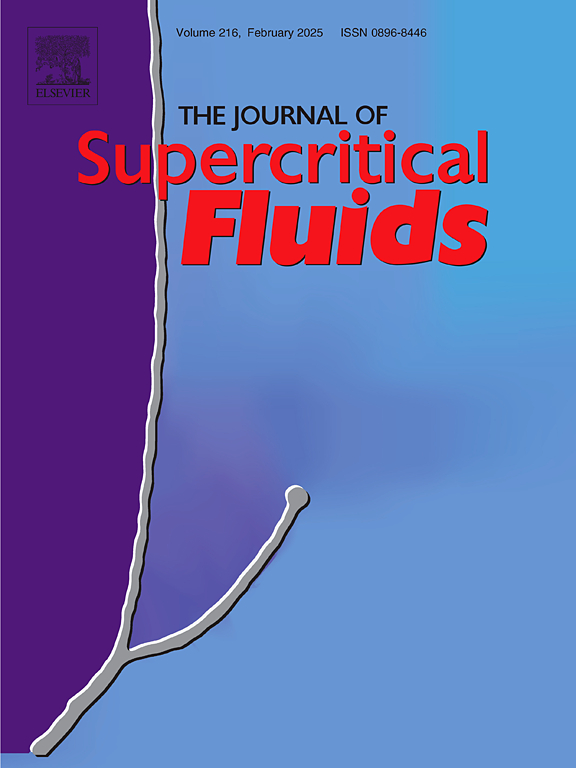Supercritical CO2 effect on the physicochemical structure of coal and its adsorption capacity: Implications for CO2 geological sequestration
IF 4.4
3区 工程技术
Q2 CHEMISTRY, PHYSICAL
引用次数: 0
Abstract
The temperature and pressure conditions of coal seams at different burial depths influence the CO2 storage potential. In this study, Fourier transform infrared spectroscopy, low-temperature nitrogen adsorption, low-field nuclear magnetic resonance, and isothermal CO2 adsorption experiments were employed to investigate the changes in functional groups, pore structures, and carbon dioxide adsorption capacity of four coal samples with varying burial depths after supercritical carbon dioxide (ScCO2) treatment under simulated in-situ temperature and pressure conditions (8 MPa to 20 MPa, 35 °C to 65 °C). Results show that ScCO2 treatment reduces the aromatic carbon content, aromatization, condensation degree of aromatic rings, aliphatic structure abundance, and the ratio of C![]() O/C
O/C![]() C in the coal samples. Additionally, ScCO2 treatment induced increases in the pore structure of coal, promoting the transformation from micropores to mesopores. Following ScCO2 treatment, the mesoporous volume of coal samples increased within the range of 2.22–41.38 %, whereas the specific surface area decreased between 9.40 % and 59.57 %. Moreover, the CO2 adsorption volume exhibited an increase ranging from 3.81 cm³ /g to 6.92 cm³ /g. A positive correlation is observed between the enhancement in CO2 adsorption capacity and both the increase in mesoporous volume as well as the decrease in C
C in the coal samples. Additionally, ScCO2 treatment induced increases in the pore structure of coal, promoting the transformation from micropores to mesopores. Following ScCO2 treatment, the mesoporous volume of coal samples increased within the range of 2.22–41.38 %, whereas the specific surface area decreased between 9.40 % and 59.57 %. Moreover, the CO2 adsorption volume exhibited an increase ranging from 3.81 cm³ /g to 6.92 cm³ /g. A positive correlation is observed between the enhancement in CO2 adsorption capacity and both the increase in mesoporous volume as well as the decrease in C![]() O/C
O/C![]() C. Notably, the maximum adsorption capacity was attained at a depth of 1000 m, making it the optimal target for CO2 injection. These findings provide theoretical guidance for selecting suitable burial depths for CO2 storage in coal seams and elucidating the interaction mechanism between ScCO2 and coal.
C. Notably, the maximum adsorption capacity was attained at a depth of 1000 m, making it the optimal target for CO2 injection. These findings provide theoretical guidance for selecting suitable burial depths for CO2 storage in coal seams and elucidating the interaction mechanism between ScCO2 and coal.
超临界CO2对煤的物理化学结构及其吸附能力的影响:对CO2地质封存的启示
不同埋深煤层的温度和压力条件影响着CO2的储存潜力。本研究采用傅立叶变换红外光谱、低温氮气吸附、低场核磁共振、等温CO2吸附实验等方法,在模拟现场温度和压力条件下(8 MPa ~ 20 MPa, 35℃~ 65℃),研究了4种不同埋深煤样在超临界二氧化碳(ScCO2)处理后官能团、孔隙结构和二氧化碳吸附能力的变化。结果表明,ScCO2处理降低了煤样中芳烃碳含量、芳构化程度、芳烃环缩合度、脂肪族结构丰度和CO/CC比。此外,ScCO2处理导致煤的孔隙结构增加,促进了微孔向中孔的转变。ScCO2处理后,煤样的介孔体积增大了2.22 ~ 41.38 %,比表面积减小了9.40 % ~ 59.57 %。CO2吸附量从3.81 cm³ /g增加到6.92 cm³ /g。CO2吸附能力的增强与介孔体积的增加和CO/CC的降低呈正相关。值得注意的是,在1000 m深度处达到最大吸附量,使其成为CO2注入的最佳目标。这些研究结果为选择适宜的煤层CO2储集深度和阐明ScCO2与煤的相互作用机制提供了理论指导。
本文章由计算机程序翻译,如有差异,请以英文原文为准。
求助全文
约1分钟内获得全文
求助全文
来源期刊

Journal of Supercritical Fluids
工程技术-工程:化工
CiteScore
7.60
自引率
10.30%
发文量
236
审稿时长
56 days
期刊介绍:
The Journal of Supercritical Fluids is an international journal devoted to the fundamental and applied aspects of supercritical fluids and processes. Its aim is to provide a focused platform for academic and industrial researchers to report their findings and to have ready access to the advances in this rapidly growing field. Its coverage is multidisciplinary and includes both basic and applied topics.
Thermodynamics and phase equilibria, reaction kinetics and rate processes, thermal and transport properties, and all topics related to processing such as separations (extraction, fractionation, purification, chromatography) nucleation and impregnation are within the scope. Accounts of specific engineering applications such as those encountered in food, fuel, natural products, minerals, pharmaceuticals and polymer industries are included. Topics related to high pressure equipment design, analytical techniques, sensors, and process control methodologies are also within the scope of the journal.
 求助内容:
求助内容: 应助结果提醒方式:
应助结果提醒方式:


